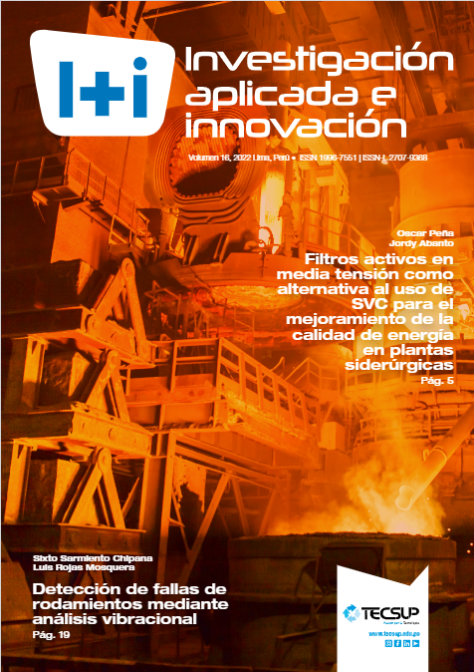Development of an air extractor for environments with covid-19
DOI:
https://doi.org/10.71701/thvr6k86Keywords:
Centrifugal fan, SARS-CoV-2, COVID-19, energy efficiency, synchronous motor, PMSM/IPM, single-phase alternating currentAbstract
The product is a centrifugal air extractor, whose objective is to extract the stale air of SARS-CoV-2 or Covid-19 (Coronavirus); designed for civil and commercial use, it works with a single- phase alternating current (AC) motor of 220 (V) and 50 (Hz), with high energy efficiency (EE). Developed under the Design Thinking methodology, by electromechanical simulation using NI Multisim 14.0 software, case design using Cfturbo 2020 R2.0 CAD software, and rapid 3D prototyping with the OverLord Pro printer; with a prototype of the conventional stator winding of a synchronous motor with a two-pole PMSM/IPM single- phase alternating current (AC) field winding and a 4000 (Gauss) ferromagnetic ceramic magnet rotor. Innovating online no 15 of invention patent no 381968 by Nikola Tesla, 5/1/1888. Based on the tests bank analysis, the results showed that the PMSM/IPM type synchronous motor used in the centrifugal fan, with the innovation of the reactance-inductive control in series plus the capacitor in parallel, reduces the power by 67%. (Watts) and active energy consumption (kWh), performing 56% more mechanical work (Joules) on the fluid air (with a 50% reduction in carbon footprint). Which leads us to the following conclusion: it is possible to develop centrifugal fans that save electricity (kWh) without the need to resort to (1) the “Fan Affinity Law”, nor (2) the use of variable speed drives ( VDF) or frequency (which are devices with complex and expensive electronics). Which would bring an enormous saving of the cost of electrical energy.the best reliability and availability of their production processes.
Downloads
References
Duval, D. et al. (2022). Long distance airborne transmission of SARS-CoV-2: rapid systematic review. bmj, 377. https://doi.org/10.1136/bmj-2021-068743
Aller, J. (2008). Máquinas eléctricas rotativas. Editorial Universidad Simón Bolívar. http://prof.usb.ve/jaller/Maquinas1.pdf
Chapman, S. J. (1987). Máquinas eléctricas (5.a ed.). Mc Graw Hill. https://frrq.cvg.utn.edu.ar/pluginfile.php/20762/mod_resource/content/1/Maquinas-electricas-Chapman-5ta-edicion-pdf.pdf
Fitzgerald, A., Kingsley, Ch., y Umans, S. (s. f.). Máquinas eléctricas (6.a ed.). Mc Graw Hill. https://www.academia.edu/17314182/maquinas_electricas
Fitzgerald, A., Kingsley, Ch., y Kusko, A. (1975). Teoría y análisis de las máquinas eléctricas. Editorial Hispano Europea. https://es.scribd.com/document/185915953/teoria-y-analisis-de-las-maquinas-electricas-fitzgerald-
kingsley-kusko
Fraile Mora, J. (2008). Máquinas eléctricas (6.a ed.). Mc Graw Hill. https://www.academia.edu/42010234/ Maquinas_electricas_6a_ed_Fraile_Mora_Jesus
Harper, G. (2006). El ABC de las máquinas eléctricas II. Motores de corriente alterna. Grupo Noriega Editores. https://es.scribd.com/doc/314652965/EL-ABC-de-Las-Maquinas-Electricas-II-Motores-de-Corriente-Alterna-Enriquez-Harper
Harper, G. (2006). El ABC de las máquinas eléctricas III. Instalación y control de motores de corriente alterna. Grupo Noriega Editores. https://es.scribd.com/document/388385650/El-ABC-de-La-Maquinas-Electricas-Instalacion-y-Control-de-Motores-de-Corriente-Alterna-Enrique-Harper-pdf
Institute of Electrical and Electronics Engineers (2016). IEEE - The world’s largest technical professional organization dedicated to advancing technology for the benefit of humanity. [Página web]. https://www.ieee.org/index.html
Mohan, N., Undeland, T., y Robbins, W. (2009). Electrónica de potencia. Convertidores, aplicaciones y diseño (3.a ed.). Mc Graw Hill. https://lc.fie.umich.mx/~jorgeahb/Pagina/ materias/PIES/electronica-de-potencia-mohan-3ra-edicion.pdf
Resnick, R., Halliday, D., y Krane, K. (2007). Física, vol. 2 (6.a ed.). Grupo Editorial Patria. https://www.academia.edu/31428733/F%C3%ADsica_Vol_2_Halliday_Resnick_and_Krane_5th_Edition_Espa%C3%B1ol
Sears, F., y Zemansky, M. (2009). Física Universitaria con Física Moderna (vol. 2). Pearson Educación. https://www.u-cursos.cl/usuario/42103e5ee2ce7442a3921d69b0200c93/mi_blog/r/Fisica_General__Fisica_Universitaria_Vol_2__ed_1%28Sears-Zemansky%29.pdf
Serway, R., y Jewett, J. (2008). Física para ciencias e ingeniería con física moderna (7.a ed.) (vol. II.). Cengage
Learning Editores. https://www.academia.edu/27915502/Serway_7_Edicion_2_Volumen
Tipler, P., y Mosca, G. (2006). Física para la ciencia y la tecnología (5.a ed.). Editorial Reverté.
Wildi, T. (2007). Máquinas eléctricas y sistemas de potencia (6.a ed.). Pearson Educación. https://lc.fie.umich.mx/~jorgeahb/Pagina/materias/Libro2.pdf
Anderson, I. (2019). Mejoras de eficiencia energética (EE) en los motores monofásicos sincrónicos de 220 (VAC)/50 (Hz), tipo PMSM. Revista UIS Ingenierías, 18(4), 57-70. https://revistas.uis.edu.co/index.php/revistauisingenierias/article/view/9300/9869
Anderson, I. (2019). Eco-turbina: turbo ventilador eléctrico 220 (VAC)–50 (Hz), de bajo consumo: eficiente energéticamente. Innovación y Desarrollo Tecnológico y Social (IDTS), 1(1), 1-28.
Canale, G. (2013). Ciclo de Vida de Productos. Aportes para su uso en Diseño Industrial. INTI. https://
proyectaryproducir.com.ar/wp-content/uploads/2015/09/ACV%20Libro%20A4%20Rev%20b%2016-12-13.pdf
Canale, G., Bernatene, M., y Flores, F. (2013). Aportes de ACV simplificado al diseño para la sustentabilidad. Casos de aplicación industrial. En V Conferencia Internacional sobre Análisis de Ciclo de Vida (pp. 2001-2013). Universidad Tecnológica Nacional. https://proyectaryproducir.com.ar/public_html/Seminarios_Posgrado/Bibliog_obligat/
CILCA%202013%20en%20castellano%20FINAL%2001-2013.pdf
Canale, G. (2014). Introducción. En Materialoteca. Perfil ambiental de materiales. https://proyectaryproducir.com.ar/public_html/Seminarios_Posgrado/Bibliog_obligat/Extracto%20de%20Introducci%C3%B3n%20-%20Materialoteca.pdf
[21] Canale, G. (2010). S.O.S. Diseño sustentable. Sustentabilidad, Economía y Diseño. En 5.o Foro de Ética y Sustentabilidad. Diseño Sustentable. Buenos Aires, 2009. Boletín 158 del INTI. https://proyectaryproducir.com.ar/public_html/Seminarios_Posgrado/Bibliog_obligat/INTI%20bol1581%20SOS%20Dse%C3%B1o%20Sustentable.pdf
Instituto Tecnológico de Canarias. (2008). Energías renovables y eficiencia energética. Canarias. ITC, S. A. https://www.cienciacanaria.es/files/Libro-de-energias-renovables-y-eficiencia-energetica.pdf
Soler & Palau (2009). Manual práctico de ventilación. Autor. https://www.solerpalau.mx/ASW/recursos/mven/spventilacionc2.pdf
Subsecretaría de ahorro y eficiencia energética (2017). Guía de eficiencia energética para motores eléctricos. Ministerio de Energía y Minería, Presidencia de la Nación. https://www.argentina.gob.ar/sites/default/files/guia_de_
eficiencia_energetica_para_motores_electricos.pdf 56 VOLUMEN 16, 2022 ÍNDICE
Zitrón (2007). Conferencias sobre ventilación en minas. Autor. https://fdocuments.ec/document/libro-de-ventilacion.html
Tesla, N. (1887). Electro-magnetic motor (US 381968A, 12-oct-1887) https://patents.google.com/patent/US381968A/en?oq=tesla+381968
NI (s. f.). Página principal. [Página web]. https://www.ni.com
Downloads
Published
Issue
Section
License

This work is licensed under a Creative Commons Attribution-NonCommercial 4.0 International License.


